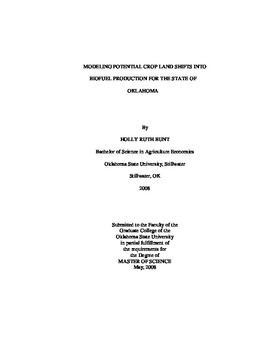| dc.contributor.advisor | Kenkel, Phil | |
| dc.contributor.author | Bunt, Holly Ruth | |
| dc.date.accessioned | 2014-04-15T18:35:16Z | |
| dc.date.available | 2014-04-15T18:35:16Z | |
| dc.date.issued | 2008-05-01 | |
| dc.identifier.uri | https://hdl.handle.net/11244/8290 | |
| dc.description.abstract | The purpose of this study is to determine the amount and regional distribution of biofuel feedstock crops that are currently produced in Oklahoma and to model the potential cropland changes for increased biofuel feedstock production. The study considers potential production of both biodiesel feedstocks (soybeans and winter canola), and grain based ethanol feedstocks (corn, grain sorghum, and hulless barley). The additional possibility of cellulosic based ethanol feedstocks such as corn stover, wheat straw or switchgrass are considered in a second scenario. The potential land conversion into biofuel feedstocks are modeled over a wide range of biofuel price levels. This provides a projection of the price response of land conversion. It should be emphasized that all land in farms is currently in use. It should be realized that a biofuels industry would bid resources from current use with possible negative impacts on some agriculture sectors. Findings and Conclusions: The results show that if cellulosic-based ethanol is commercialized, then an overwhelming amount of ethanol can be produced when only 49.52% of total crop acres are converted to switchgrass or hulless barley with a biofuel price of $2.50/gallon. If the situation arises where cellulosic-based ethanol is not able to be commercially produced then the next best use of 48.40% of crop land in Oklahoma would be to produce grain-based ethanol from corn and sorghum, while converting all other crops into one of the two previously stated crops. While this study has a number of limitations it does provide an important first step in identifying and quantifying Oklahoma's potential in the biofuel industry. Biofuel production could provide the incentives for substantial cropping shifts, largely at the expense of hay and wheat production, which is Oklahoma's largest crop. This study projected when producers would have an economic incentive to convert their current crops into biofuel feedstock crops. As well, it models at what price points Oklahoma would have the greatest number of gallons of biofuel produced and what percent of crop acres must be converted to produce each level of biofuel gallons. The study did not attempt to model the likelihood or time path of such conversions. A significant investment in infrastructure would also be required before Oklahoma can realize the potential identified in this study. | |
| dc.format | application/pdf | |
| dc.language | en_US | |
| dc.publisher | Oklahoma State University | |
| dc.rights | Copyright is held by the author who has granted the Oklahoma State University Library the non-exclusive right to share this material in its institutional repository. Contact Digital Library Services at lib-dls@okstate.edu or 405-744-9161 for the permission policy on the use, reproduction or distribution of this material. | |
| dc.title | Modeling Potential Crop Land Shifts into Biofuel Production for the State of Oklahoma | |
| dc.type | text | |
| dc.contributor.committeeMember | Holcomb, Rodney | |
| dc.contributor.committeeMember | Dicks, Mike | |
| osu.filename | Bunt_okstate_0664M_2661.pdf | |
| osu.college | Agricultural Sciences and Natural Resources | |
| osu.accesstype | Open Access | |
| dc.description.department | Department of Agricultural Economics | |
| dc.type.genre | Thesis | |
